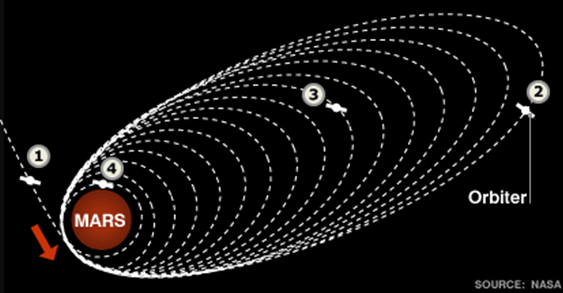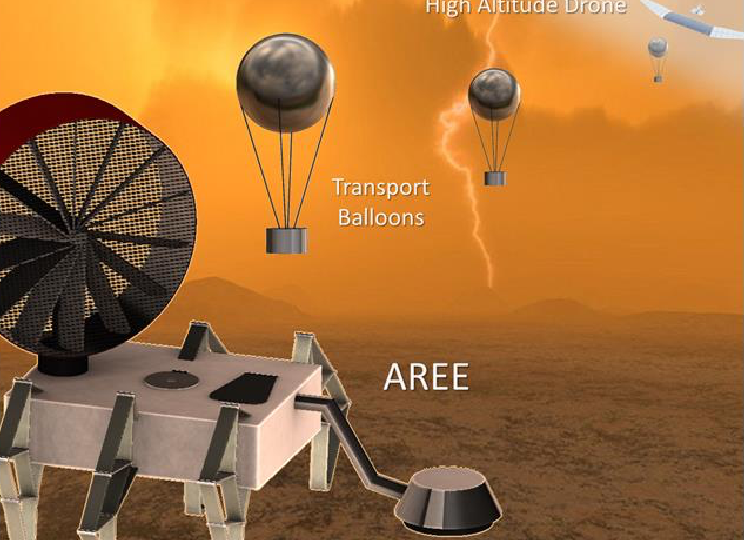Asteroid machine, "two-dimensional" ship and 11 more crazy ideas from NASA

Each year, NASA runs a NASA Innovative Advanced Concepts (NIAC) program for engineers and inventors to select the most interesting ideas that can come true sometime in the future. Participants are encouraged not to limit their imagination and offer "radical improvements for existing technologies or completely new concepts." The best projects receive little funding for more detailed study.
Recently, a NASA committee identified a list of 13 participants in the 2016 NIAC program. Among them are NASA employees, private firms and university teams. All teams offered very interesting ideas.
Lightweight multi-function planetary probe for research and movement in extreme weather conditions.
Virginia Polytechnic University and State University
')

Developers offer a new shield design to protect against heat when descending in the atmosphere. This shield is also a landing gear. After descent, the probe will be able to roll over the surface of the planet.
Atmospheric probe for Venus using local energy sources
NASA Jet Propulsion Laboratory

It is intended to carry out the electrolysis of water using electricity from photo panels. The resulting hydrogen is stored and, if necessary, pumped into the shell of the ball for gaining a height probe. It is used as fuel. Such a method will allow one to descend to research in the lower layers of the atmosphere, where there is not enough light for photo panels, and then to rise back.
Transformation of asteroids into mechanical automata
Made In Space, Inc.

The company offers an original method of moving asteroids — send robots with tools and fuel to the surface that will build the basic subsystems of a spacecraft using local material. After that, the asteroid itself will, in fact, turn into a spacecraft.
Analysis of the molecular composition of distant objects
California Polytechnic University

The proposed system will be able to determine the molecular composition of cold objects, such as asteroids, comets, planets, satellites of planets, from a convenient position from a distance. For this purpose, a laser will be shot at the object in order to evaporate a little matter, and then the spectrometer will be aimed at the hot spot through the layer of evaporated gas.
Brane Craft
The Aerospace Corporation

Almost two-dimensional spacecraft, which consists of a film. This design gives it a power to weight ratio of 7.7 kW / kg. Engines are applied by electrospray. Fuel is stored in a 10 micron layer between two kapton sheets. This fuel is enough to travel from Earth's orbit to Mars and back. Instead of conventional sensors, this ship needs two-dimensional ones, weighing no more than 35 g per 1 m 2 . The device is supposed to be used for clearing debris in low earth orbit.
Exoplanet discovery in star echo
Nanohmics, Inc.

All stars range from nanoseconds to days. These vibrations can be used to detect exoplanets, if you use modern computing technology. Theoretically, such a technique provides even higher resolution than interferometers.
Mars Molniya Orbit Atmospheric Resource Mining
Kennedy Space Center NASA

Apparently, the conceptually new architecture somehow helps to “catch” and lower cargo and crews from the Earth onto the Martian surface.
Journey to the center of the ice moons
NASA Jet Propulsion Laboratory

In the classic science fiction novel by Jules Verne, Journey to the Center of the Earth, Professor Otto Lidenbrock and his group descended into the mouth of an Icelandic volcano, and there they found the underground ocean and other wonders below. This is why NASA's Jet Propulsion Laboratory is seeking to make the same trip on Europe and Enceladus. They propose to use a triple system from the apparatus on the surface (SM), the descent module (DM) and the underwater modules (AUV).
E-Glider: active electrostatic flight for the study of cosmic bodies without atmosphere
NASA Jet Propulsion Laboratory

The space around the non-atmospheric bodies (asteroids, comets, moon) carries an electric charge due to photoelectric solar bombardment. The electrostatic glider will interact with this field at the expense of its own charge.
Electronics recycling and printing
Ames Research Center at NASA

Synthetically improved microbes (GMOs) eat old electronics, and then the microorganisms themselves are used as material for printing new electronics. The technology will be used both on Earth and on Mars: you can use gas from the Martian atmosphere.
Mechanical rovers for extreme environments
NASA Jet Propulsion Laboratory

Venus with clouds of sulfuric acid, extreme temperature and pressure - one of the most hostile places in the solar system. Only a couple of Soviet vehicles could reach its surface. Even these reliable probes managed to last only 23 and 127 minutes before the electronics went down. NASA offers a fully mechanical construction with hardened metal - such a device will have chances.
The concept of a mechanical automaton, an autonomous machine that fulfills the instructions laid down, has been known for 2300 years since the Antikythera Mechanism (a mechanical computer from Ancient Greece). NASA proposes replacing electronic computers with automatic machines for exploring the most hostile places: Venus, Mercury, Jupiter's magnetosphere, gas giants, the Earth's mantle and volcanoes everywhere in the Solar System.
Orbital and descent modules for Pluto on a portable fusion reactor
Princeton Satellite Systems, Inc.

A fusion reactor for the Direct Fusion Drive (DFD) type engine is currently under development at Princeton. The developed traction due to the reactor is enough to deliver a ton of cargo to Pluto in 4-6 years. Upon arrival, the reactor will produce a power of 2 MW. This is enough for broadband communication with the Earth, power supply of the descent module from orbit and a radically expanded set of tools. Despite the recent passage past the New Horizons' Pluto apparatus, we still have very little information about this dwarf planet.
NIMPH: self-propelled mini sample collector on Jupiter's ice moons
Exoterra Resource, LLC

Collecting soil samples from Mars, the Moon, and Jupiter’s moons is one of NASA’s top priorities. But this is a very expensive procedure using traditional methods. The NIMPH project provides for a reduction of the budget due to the use of solar energy, cheap CubeSat type nanosatellites and local water resources on icy space bodies. A self-propelled nanosatellite falls to the surface, which itself then takes off along with the sample. By such methods, for example, the mission to Europe can be cheapened by an order of magnitude.
Source: https://habr.com/ru/post/393021/
All Articles